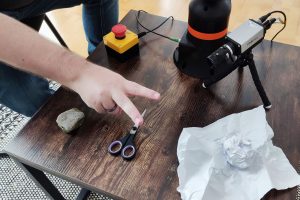What would you do if you suddenly felt like playing “rock, paper, scissors”, but there was no human player available? For Sebastian Trella from robots blog.com, the solution is obvious: he simply makes sure that a robot steps in. Namely, with the help of an intelligent IDS NXT camera. The first step to make this happen: the implementation of gesture recognition using image processing.
 Sebastian Trella is passionate about technology and robotics. He is always taking on new tasks and explaining new projects in his blog. However, he has hardly ever worked with image processing. Since a colleague’s LEGO® MINDSTORMS® robot could recognise the gestures of a hand with several different sensors, he got an idea: “The robot should be able to see.” Until now, the respective gesture had to be made at a very specific point in front of the robot in order to be reliably recognised. Several sensors were needed for this, which made the system inflexible and dampened the joy of playing. Can image processing solve this task more “elegantly”?
Sebastian Trella is passionate about technology and robotics. He is always taking on new tasks and explaining new projects in his blog. However, he has hardly ever worked with image processing. Since a colleague’s LEGO® MINDSTORMS® robot could recognise the gestures of a hand with several different sensors, he got an idea: “The robot should be able to see.” Until now, the respective gesture had to be made at a very specific point in front of the robot in order to be reliably recognised. Several sensors were needed for this, which made the system inflexible and dampened the joy of playing. Can image processing solve this task more “elegantly”?
In his search for a suitable camera, he came across IDS NXT, a comprehensice system for the use of intelligent image processing by IDS Imaging Development Systems. It fulfilled all the requirements and, thanks to artificial intelligence, much more besides pure gesture recognition. Trella’s interest was aroused. This is because the evaluation of the images and the communication of the results took place directly on or through the camera – without an additional PC. In addition, the IDS NXT Experience Kit came with all the components needed to start using the application immediately – without any prior knowledge of AI.
 Helping a robot to understand the rules of the game
Helping a robot to understand the rules of the game
Trella took the idea further and began to develop a robot that would play the game “Rock, Paper, Scissors” in the future with a process similar to that in the classical sense: The (human) player is asked to perform one of the familiar gestures (scissors, stone, paper) in front of the camera. The virtual opponent has already randomly determined his gesture at this point. The move is evaluated in real time and the winner is displayed.
But until then, some intermediate steps were necessary. Trella began by implementing gesture recognition using image processing – new territory for the robotics fan. However, with the help of IDS lighthouse, a cloud-based AI vision studio, this was easier to realise than expected. Here, ideas evolve into complete applications. For this purpose, neural networks are trained by application images with the necessary product knowledge, such as in this case the individual gestures from different perspectives, and packaged into a suitable application workflow.
Training a neural network without extensive previous knowledge
“ The training process was super easy and I just used IDS lighthouse’s step-by-step wizard after taking several hundred pictures of my hands using rock, scissor or paper gestures from different angles against different backgrounds. The first trained AI was able to reliably recognise the gestures directly,” explains Sebastian Trella. This works for both left- and right-handers with a recognition rate of approx. 95%. Probabilities are returned for the labels “Rock”, “Paper”, “Scissor” or “Nothing”. A satisfactory result. But what happens now with the data obtained?
The training process was super easy and I just used IDS lighthouse’s step-by-step wizard after taking several hundred pictures of my hands using rock, scissor or paper gestures from different angles against different backgrounds. The first trained AI was able to reliably recognise the gestures directly,” explains Sebastian Trella. This works for both left- and right-handers with a recognition rate of approx. 95%. Probabilities are returned for the labels “Rock”, “Paper”, “Scissor” or “Nothing”. A satisfactory result. But what happens now with the data obtained?
The further processing of the recognised gestures could be done by means of a specially created vision app. For this, the captured image of the respective gesture – after evaluation by the AI – must be passed on to the app. The latter “knows” the rules of the game and can thus decide which gesture beats another. It then determines the winner. In the first stage of development, the app will also simulate the opponent. All this is currently in the making and will be implemented in the next step to become a “Rock, Paper, Scissors”-playing robot.
If you would like to follow his journey, keep an eye on the IDS Knowlede Base. Here, the camera manudacturer regularly publishes case studies on industrial image processing, as well as the continuation of Trella’s project.
IDS Imaging Development Systems Limited
Cheyenne House, West Street
GU9 7EQ Farnham
United Kingdom
Phone: +44 1252 916 656

